Corporate Accounting Report: Boral Limited Tax Analysis, 2017
VerifiedAdded on 2020/05/28
|11
|2692
|105
Report
AI Summary
This report provides a detailed analysis of the corporate accounting practices of Boral Limited. It begins by examining the equity section of the balance sheet, focusing on issued capital, reserves, and retained earnings, highlighting significant changes between 2016 and 2017. The report then delves into the calculation and reconciliation of tax expenses, comparing the amounts reported in the income statement and the statement of cash flows. It explores the factors contributing to the differences in tax expenses, including differences in tax rates, non-deductible items, and the impact of deferred tax assets and liabilities. The analysis also covers current tax assets and liabilities, and the reasons for discrepancies between income tax expenses and income tax payable. Finally, the report concludes with an assessment of Boral Limited's tax treatment, emphasizing the clarity and justification provided in its financial reporting. The report utilizes Boral Limited's annual reports to support its findings and conclusions.
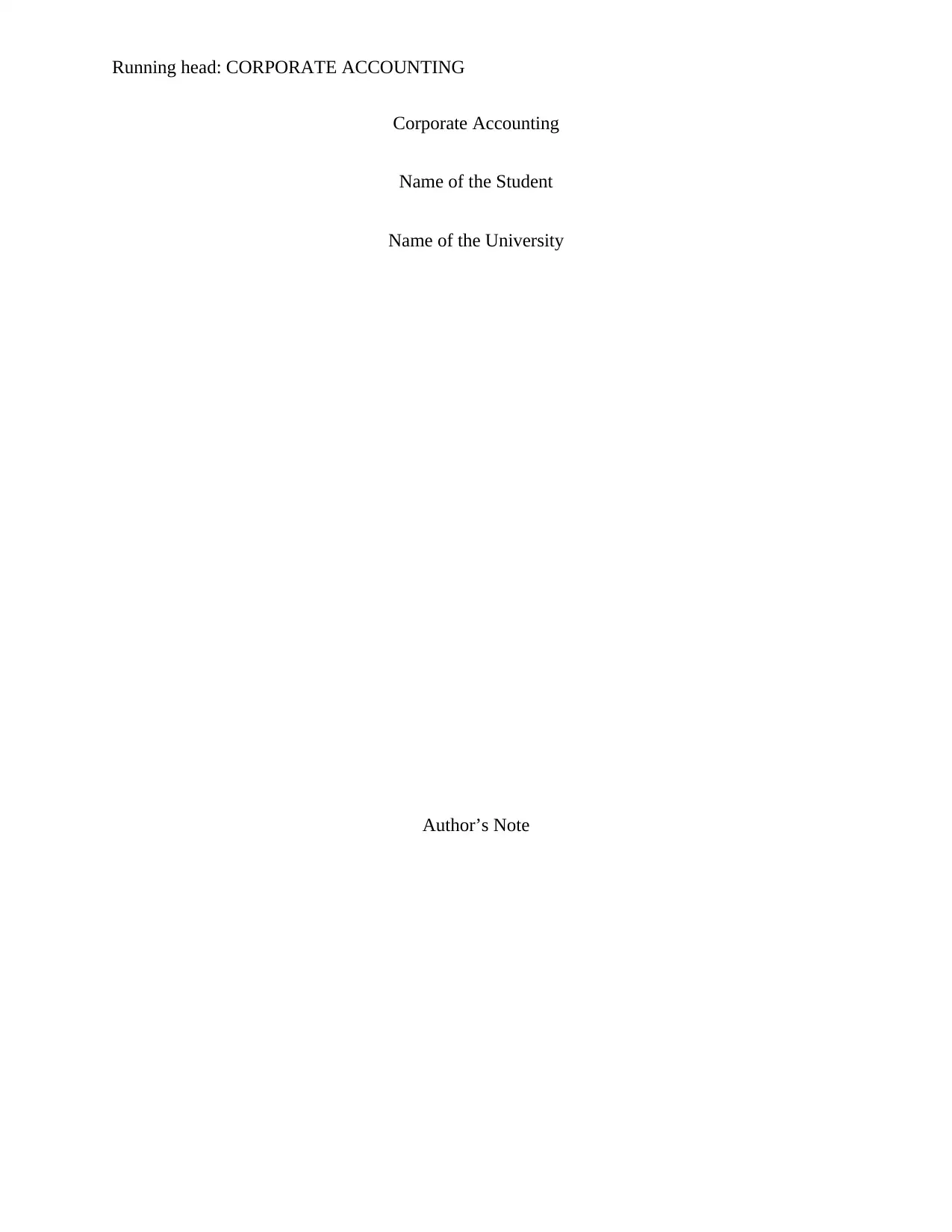
Running head: CORPORATE ACCOUNTING
Corporate Accounting
Name of the Student
Name of the University
Author’s Note
Corporate Accounting
Name of the Student
Name of the University
Author’s Note
Paraphrase This Document
Need a fresh take? Get an instant paraphrase of this document with our AI Paraphraser
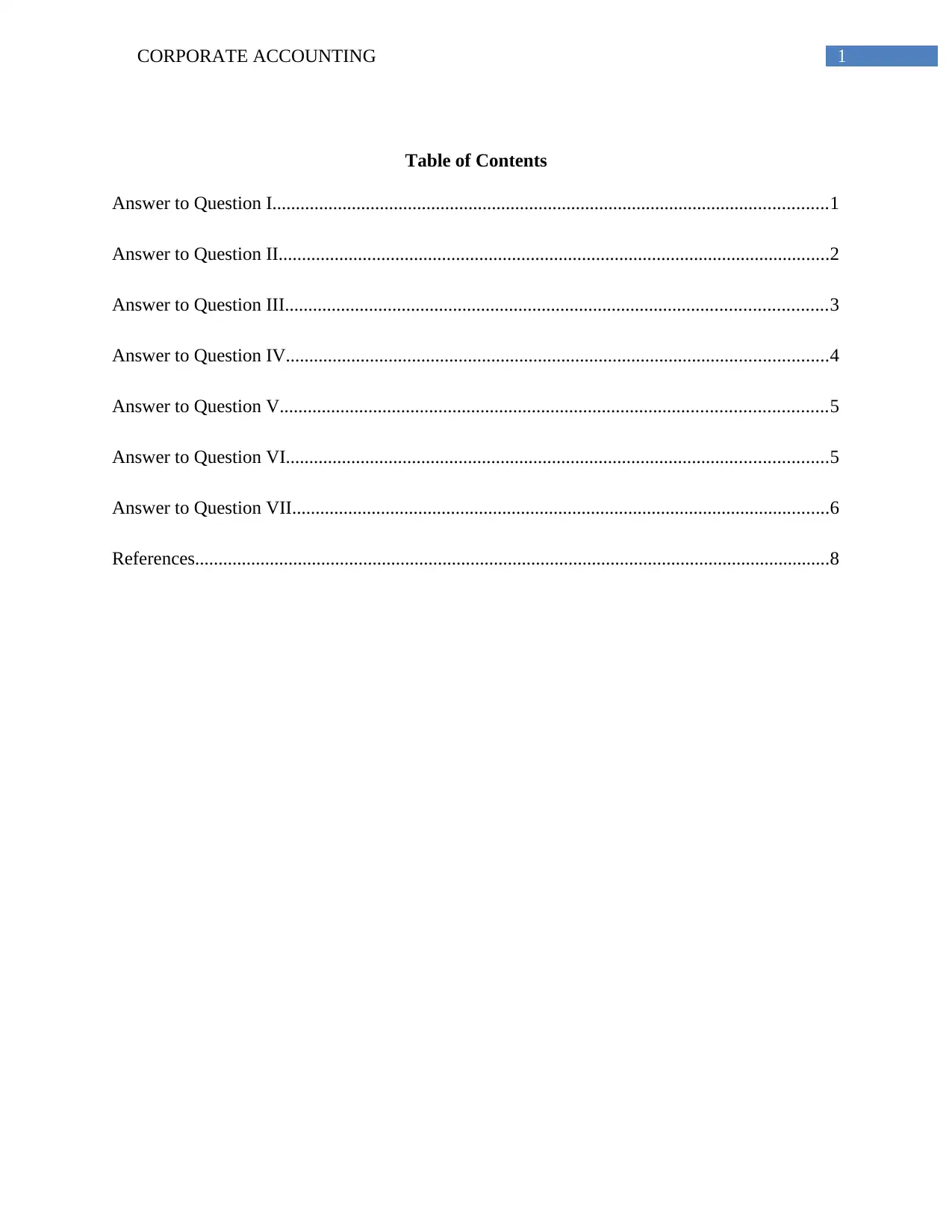
1CORPORATE ACCOUNTING
Table of Contents
Answer to Question I.......................................................................................................................1
Answer to Question II......................................................................................................................2
Answer to Question III....................................................................................................................3
Answer to Question IV....................................................................................................................4
Answer to Question V.....................................................................................................................5
Answer to Question VI....................................................................................................................5
Answer to Question VII...................................................................................................................6
References........................................................................................................................................8
Table of Contents
Answer to Question I.......................................................................................................................1
Answer to Question II......................................................................................................................2
Answer to Question III....................................................................................................................3
Answer to Question IV....................................................................................................................4
Answer to Question V.....................................................................................................................5
Answer to Question VI....................................................................................................................5
Answer to Question VII...................................................................................................................6
References........................................................................................................................................8
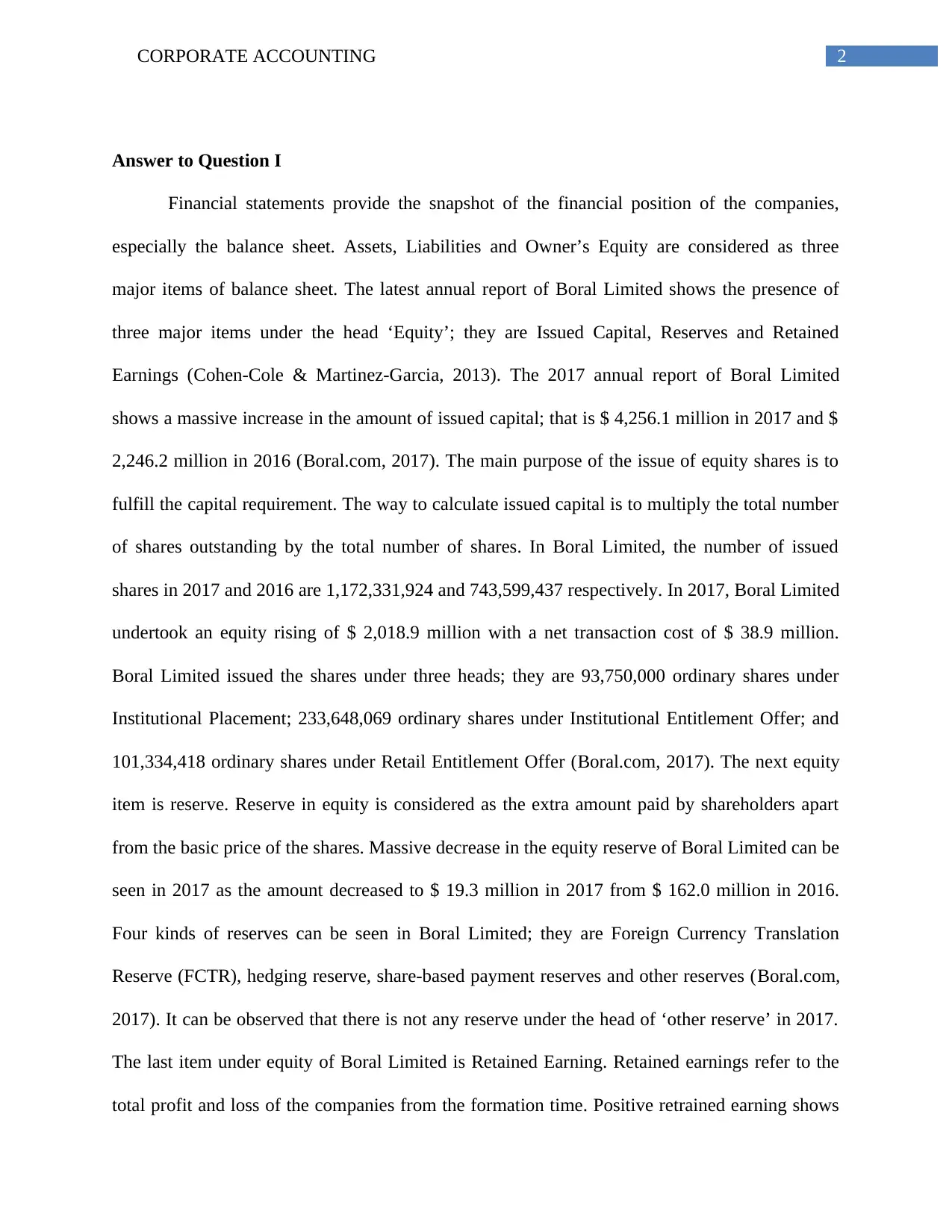
2CORPORATE ACCOUNTING
Answer to Question I
Financial statements provide the snapshot of the financial position of the companies,
especially the balance sheet. Assets, Liabilities and Owner’s Equity are considered as three
major items of balance sheet. The latest annual report of Boral Limited shows the presence of
three major items under the head ‘Equity’; they are Issued Capital, Reserves and Retained
Earnings (Cohen-Cole & Martinez-Garcia, 2013). The 2017 annual report of Boral Limited
shows a massive increase in the amount of issued capital; that is $ 4,256.1 million in 2017 and $
2,246.2 million in 2016 (Boral.com, 2017). The main purpose of the issue of equity shares is to
fulfill the capital requirement. The way to calculate issued capital is to multiply the total number
of shares outstanding by the total number of shares. In Boral Limited, the number of issued
shares in 2017 and 2016 are 1,172,331,924 and 743,599,437 respectively. In 2017, Boral Limited
undertook an equity rising of $ 2,018.9 million with a net transaction cost of $ 38.9 million.
Boral Limited issued the shares under three heads; they are 93,750,000 ordinary shares under
Institutional Placement; 233,648,069 ordinary shares under Institutional Entitlement Offer; and
101,334,418 ordinary shares under Retail Entitlement Offer (Boral.com, 2017). The next equity
item is reserve. Reserve in equity is considered as the extra amount paid by shareholders apart
from the basic price of the shares. Massive decrease in the equity reserve of Boral Limited can be
seen in 2017 as the amount decreased to $ 19.3 million in 2017 from $ 162.0 million in 2016.
Four kinds of reserves can be seen in Boral Limited; they are Foreign Currency Translation
Reserve (FCTR), hedging reserve, share-based payment reserves and other reserves (Boral.com,
2017). It can be observed that there is not any reserve under the head of ‘other reserve’ in 2017.
The last item under equity of Boral Limited is Retained Earning. Retained earnings refer to the
total profit and loss of the companies from the formation time. Positive retrained earning shows
Answer to Question I
Financial statements provide the snapshot of the financial position of the companies,
especially the balance sheet. Assets, Liabilities and Owner’s Equity are considered as three
major items of balance sheet. The latest annual report of Boral Limited shows the presence of
three major items under the head ‘Equity’; they are Issued Capital, Reserves and Retained
Earnings (Cohen-Cole & Martinez-Garcia, 2013). The 2017 annual report of Boral Limited
shows a massive increase in the amount of issued capital; that is $ 4,256.1 million in 2017 and $
2,246.2 million in 2016 (Boral.com, 2017). The main purpose of the issue of equity shares is to
fulfill the capital requirement. The way to calculate issued capital is to multiply the total number
of shares outstanding by the total number of shares. In Boral Limited, the number of issued
shares in 2017 and 2016 are 1,172,331,924 and 743,599,437 respectively. In 2017, Boral Limited
undertook an equity rising of $ 2,018.9 million with a net transaction cost of $ 38.9 million.
Boral Limited issued the shares under three heads; they are 93,750,000 ordinary shares under
Institutional Placement; 233,648,069 ordinary shares under Institutional Entitlement Offer; and
101,334,418 ordinary shares under Retail Entitlement Offer (Boral.com, 2017). The next equity
item is reserve. Reserve in equity is considered as the extra amount paid by shareholders apart
from the basic price of the shares. Massive decrease in the equity reserve of Boral Limited can be
seen in 2017 as the amount decreased to $ 19.3 million in 2017 from $ 162.0 million in 2016.
Four kinds of reserves can be seen in Boral Limited; they are Foreign Currency Translation
Reserve (FCTR), hedging reserve, share-based payment reserves and other reserves (Boral.com,
2017). It can be observed that there is not any reserve under the head of ‘other reserve’ in 2017.
The last item under equity of Boral Limited is Retained Earning. Retained earnings refer to the
total profit and loss of the companies from the formation time. Positive retrained earning shows
⊘ This is a preview!⊘
Do you want full access?
Subscribe today to unlock all pages.

Trusted by 1+ million students worldwide
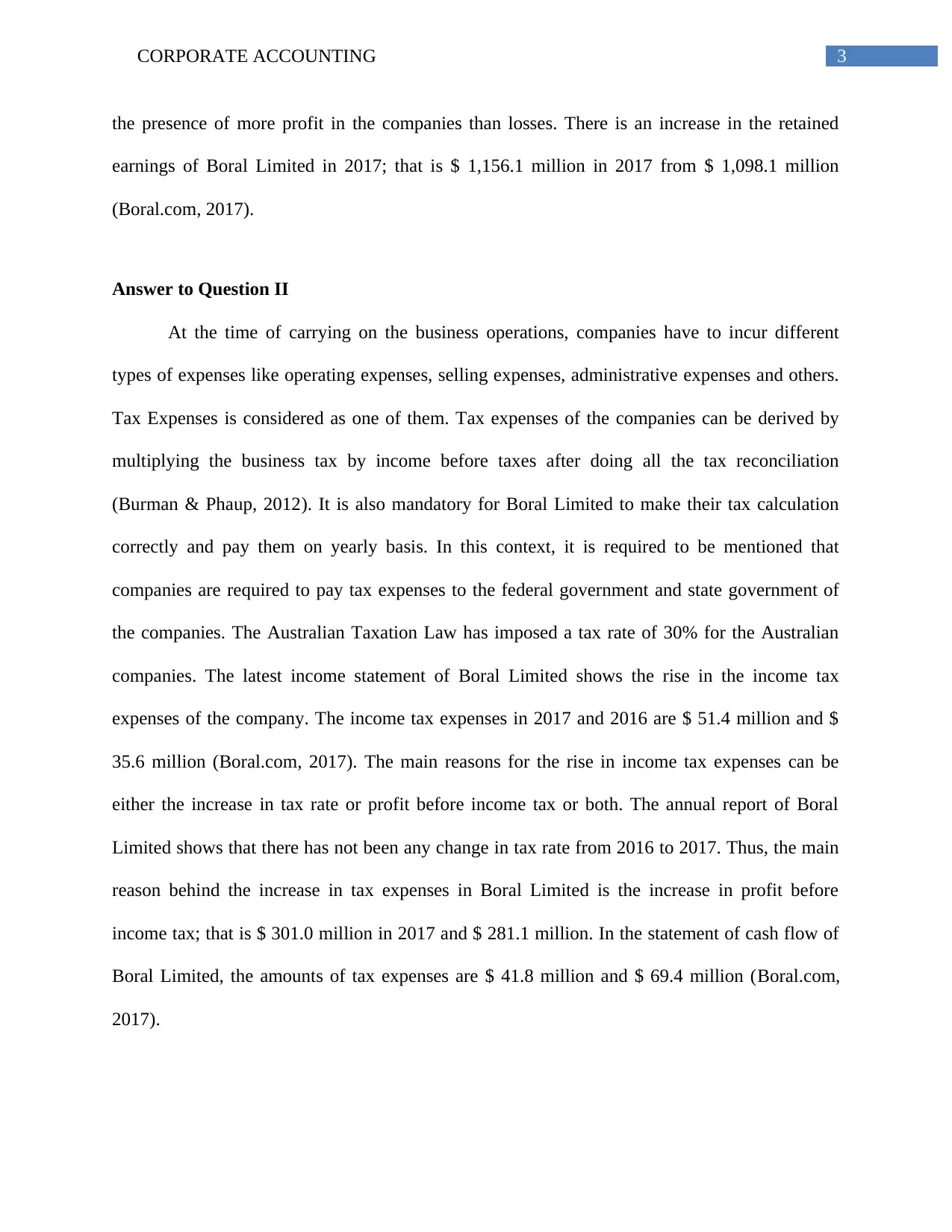
3CORPORATE ACCOUNTING
the presence of more profit in the companies than losses. There is an increase in the retained
earnings of Boral Limited in 2017; that is $ 1,156.1 million in 2017 from $ 1,098.1 million
(Boral.com, 2017).
Answer to Question II
At the time of carrying on the business operations, companies have to incur different
types of expenses like operating expenses, selling expenses, administrative expenses and others.
Tax Expenses is considered as one of them. Tax expenses of the companies can be derived by
multiplying the business tax by income before taxes after doing all the tax reconciliation
(Burman & Phaup, 2012). It is also mandatory for Boral Limited to make their tax calculation
correctly and pay them on yearly basis. In this context, it is required to be mentioned that
companies are required to pay tax expenses to the federal government and state government of
the companies. The Australian Taxation Law has imposed a tax rate of 30% for the Australian
companies. The latest income statement of Boral Limited shows the rise in the income tax
expenses of the company. The income tax expenses in 2017 and 2016 are $ 51.4 million and $
35.6 million (Boral.com, 2017). The main reasons for the rise in income tax expenses can be
either the increase in tax rate or profit before income tax or both. The annual report of Boral
Limited shows that there has not been any change in tax rate from 2016 to 2017. Thus, the main
reason behind the increase in tax expenses in Boral Limited is the increase in profit before
income tax; that is $ 301.0 million in 2017 and $ 281.1 million. In the statement of cash flow of
Boral Limited, the amounts of tax expenses are $ 41.8 million and $ 69.4 million (Boral.com,
2017).
the presence of more profit in the companies than losses. There is an increase in the retained
earnings of Boral Limited in 2017; that is $ 1,156.1 million in 2017 from $ 1,098.1 million
(Boral.com, 2017).
Answer to Question II
At the time of carrying on the business operations, companies have to incur different
types of expenses like operating expenses, selling expenses, administrative expenses and others.
Tax Expenses is considered as one of them. Tax expenses of the companies can be derived by
multiplying the business tax by income before taxes after doing all the tax reconciliation
(Burman & Phaup, 2012). It is also mandatory for Boral Limited to make their tax calculation
correctly and pay them on yearly basis. In this context, it is required to be mentioned that
companies are required to pay tax expenses to the federal government and state government of
the companies. The Australian Taxation Law has imposed a tax rate of 30% for the Australian
companies. The latest income statement of Boral Limited shows the rise in the income tax
expenses of the company. The income tax expenses in 2017 and 2016 are $ 51.4 million and $
35.6 million (Boral.com, 2017). The main reasons for the rise in income tax expenses can be
either the increase in tax rate or profit before income tax or both. The annual report of Boral
Limited shows that there has not been any change in tax rate from 2016 to 2017. Thus, the main
reason behind the increase in tax expenses in Boral Limited is the increase in profit before
income tax; that is $ 301.0 million in 2017 and $ 281.1 million. In the statement of cash flow of
Boral Limited, the amounts of tax expenses are $ 41.8 million and $ 69.4 million (Boral.com,
2017).
Paraphrase This Document
Need a fresh take? Get an instant paraphrase of this document with our AI Paraphraser

4CORPORATE ACCOUNTING
Answer to Question III
The latest annual report of Boral Limited shows the company’s profit before tax in 2017
and 2016 are $ 301.0 million and $ 281.1 million respectively and the company has an income
tax rate of 30% in both the year 2017 and 2016. In this way, the tax expenses of Boral Limited
should be $ 90.3 million ($ 301.0 million*30%) in 2017 and $ 84.33 million ($ 281.1
million*30%) in 2016. However, in the company’s income statement, the reported amount of
tax expenses is $ 51.4 million and $ 35.6 million (Boral.com, 2017). Thus, it shows a clear
difference in the tax expenses for Boral Limited. The reconciliation of income tax expenses
shows that several factors contribute to this difference in income tax expenses. The first factor is
the difference between Australian and overseas tax rate (Marron, 2012). The tax expenses among
the parent company and its subsidiaries in other countries due to difference in tax rates and $ 3.4
million has been deducted from the tax expenses. The next factor is non-deductable depreciation
and amortization. In 2017, Boral Limited has deducted depreciation and amortization from tax
expenses and thus, $ 0.4 million has been added with the tax expenses (Boral.com, 2017). In the
tax treatment of Boral Limited, one deductible item is the realization of the losses of capital and
income tax. For this reason, $ 20.4 million is deducted from the tax expenses. The next item is
non-deductable asset impairment and write-downs. In-spite of non-deductable nature, the
company may have deducted them and as compensation, $ 6.1 million has been added with the
tax expenses. The next item is shares of associates’ net profits that should be deducted from the
income tax expenses. For this reason, $ 28.5 million has been deducted from the tax expenses
(Boral.com, 2017). The next item is tax benefits from the vest of share acquisition right. This is a
deductable item from the profit of the companies. For this reason, $ 11.5 million has been
deducted from the income tax expenses of the company. The next item is finalization of different
Answer to Question III
The latest annual report of Boral Limited shows the company’s profit before tax in 2017
and 2016 are $ 301.0 million and $ 281.1 million respectively and the company has an income
tax rate of 30% in both the year 2017 and 2016. In this way, the tax expenses of Boral Limited
should be $ 90.3 million ($ 301.0 million*30%) in 2017 and $ 84.33 million ($ 281.1
million*30%) in 2016. However, in the company’s income statement, the reported amount of
tax expenses is $ 51.4 million and $ 35.6 million (Boral.com, 2017). Thus, it shows a clear
difference in the tax expenses for Boral Limited. The reconciliation of income tax expenses
shows that several factors contribute to this difference in income tax expenses. The first factor is
the difference between Australian and overseas tax rate (Marron, 2012). The tax expenses among
the parent company and its subsidiaries in other countries due to difference in tax rates and $ 3.4
million has been deducted from the tax expenses. The next factor is non-deductable depreciation
and amortization. In 2017, Boral Limited has deducted depreciation and amortization from tax
expenses and thus, $ 0.4 million has been added with the tax expenses (Boral.com, 2017). In the
tax treatment of Boral Limited, one deductible item is the realization of the losses of capital and
income tax. For this reason, $ 20.4 million is deducted from the tax expenses. The next item is
non-deductable asset impairment and write-downs. In-spite of non-deductable nature, the
company may have deducted them and as compensation, $ 6.1 million has been added with the
tax expenses. The next item is shares of associates’ net profits that should be deducted from the
income tax expenses. For this reason, $ 28.5 million has been deducted from the tax expenses
(Boral.com, 2017). The next item is tax benefits from the vest of share acquisition right. This is a
deductable item from the profit of the companies. For this reason, $ 11.5 million has been
deducted from the income tax expenses of the company. The next item is finalization of different

5CORPORATE ACCOUNTING
tax matters that does not have any effect on the tax expenses of Boral Limited in 2017. There are
some other non-deductable significant other items can be seen that are not required to be
deducted from the tax expenses. For this reason, $ 3.7 million has been added to the tax expenses
of the company (Boral.com, 2017).
Answer to Question IV
Deferred tax assets and liabilities are two important parts in the tax treatment of the firms.
In some situations, companies use to pay extra amount of tax in the current year that is
considered as asset in the coming years and it is called deferred tax assets (Harrington, Smith &
Trippeer, 2012). In some situations, there are differences in profit and tax-carrying value of the
firms and it is called deferred tax liabilities (Gallemore et al., 2012). The latest annual report of
Boral Limited shows the reporting of differed tax assets in the balance sheet; they are $ 128.4
million in 2017 and $ 237.4 million in 2016 (Boral.com, 2017). Thus, decrease in the deferred
tax assets can be seen in 2017 as compared to 2016. The financial notes of deferred tax and
assets show the presence of differed tax assets and liabilities in both 2017 and 2016. In Boral
Limited, the deferred tax assets are receivables, inventories, PPE (property, plant and equipment)
and intangible assets. Boral Limited has recognized all these substances as their deferred tax
assets it is probable that future taxable profits will be available from all these assets. The
situation is opposite in case of deferred tax liabilities. Boral Limited has recognized all these
substances as their deferred tax liabilities as it is probable that there will be future outflow of
cash or losses due from these items. There can be a major reason for Boral Limited for the
reduction of deferred tax assets in 2017 from 2016 that is the overpayment of tax in 2016. Boral
Limited had to pay less amount of tax in 2017 as they already paid overtax in 2016.
tax matters that does not have any effect on the tax expenses of Boral Limited in 2017. There are
some other non-deductable significant other items can be seen that are not required to be
deducted from the tax expenses. For this reason, $ 3.7 million has been added to the tax expenses
of the company (Boral.com, 2017).
Answer to Question IV
Deferred tax assets and liabilities are two important parts in the tax treatment of the firms.
In some situations, companies use to pay extra amount of tax in the current year that is
considered as asset in the coming years and it is called deferred tax assets (Harrington, Smith &
Trippeer, 2012). In some situations, there are differences in profit and tax-carrying value of the
firms and it is called deferred tax liabilities (Gallemore et al., 2012). The latest annual report of
Boral Limited shows the reporting of differed tax assets in the balance sheet; they are $ 128.4
million in 2017 and $ 237.4 million in 2016 (Boral.com, 2017). Thus, decrease in the deferred
tax assets can be seen in 2017 as compared to 2016. The financial notes of deferred tax and
assets show the presence of differed tax assets and liabilities in both 2017 and 2016. In Boral
Limited, the deferred tax assets are receivables, inventories, PPE (property, plant and equipment)
and intangible assets. Boral Limited has recognized all these substances as their deferred tax
assets it is probable that future taxable profits will be available from all these assets. The
situation is opposite in case of deferred tax liabilities. Boral Limited has recognized all these
substances as their deferred tax liabilities as it is probable that there will be future outflow of
cash or losses due from these items. There can be a major reason for Boral Limited for the
reduction of deferred tax assets in 2017 from 2016 that is the overpayment of tax in 2016. Boral
Limited had to pay less amount of tax in 2017 as they already paid overtax in 2016.
⊘ This is a preview!⊘
Do you want full access?
Subscribe today to unlock all pages.

Trusted by 1+ million students worldwide
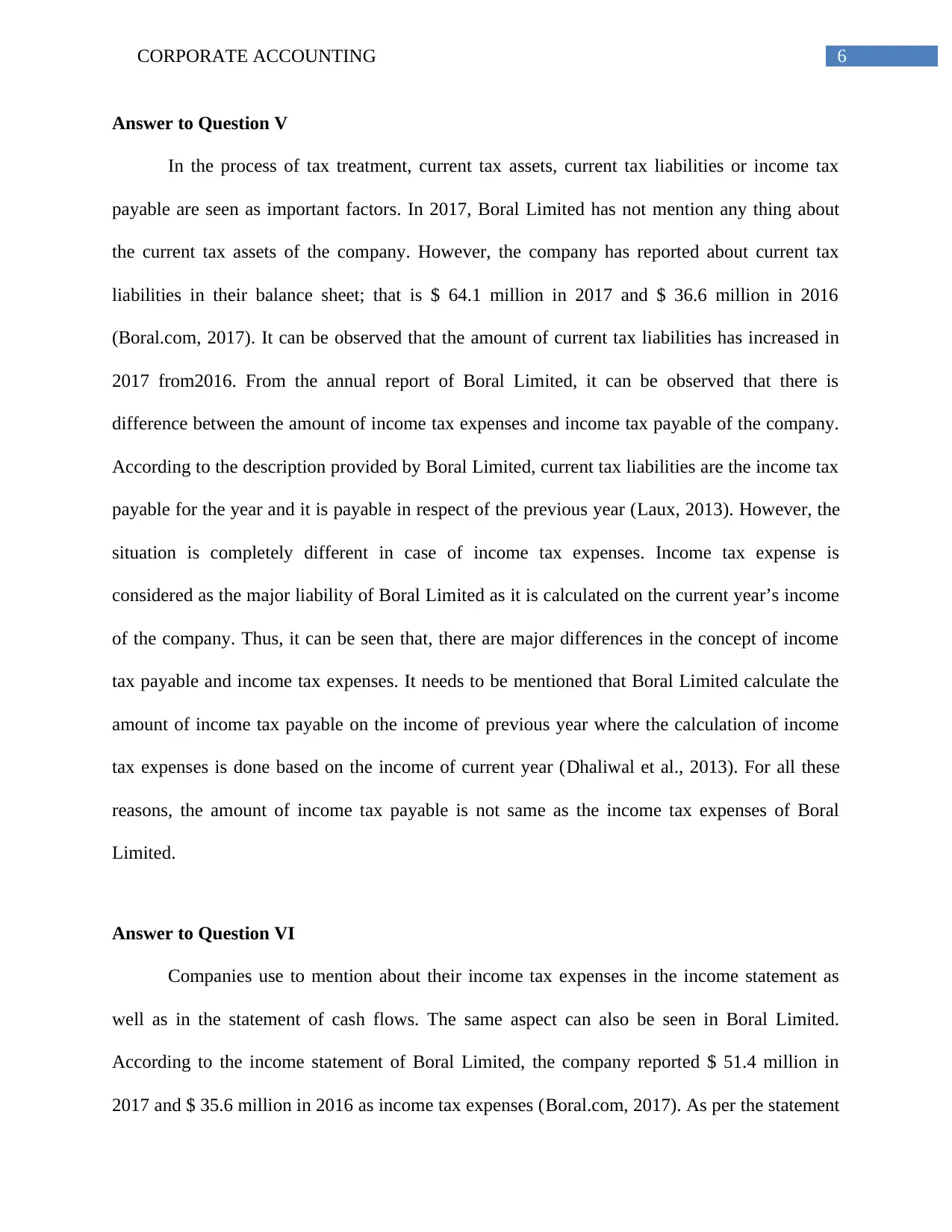
6CORPORATE ACCOUNTING
Answer to Question V
In the process of tax treatment, current tax assets, current tax liabilities or income tax
payable are seen as important factors. In 2017, Boral Limited has not mention any thing about
the current tax assets of the company. However, the company has reported about current tax
liabilities in their balance sheet; that is $ 64.1 million in 2017 and $ 36.6 million in 2016
(Boral.com, 2017). It can be observed that the amount of current tax liabilities has increased in
2017 from2016. From the annual report of Boral Limited, it can be observed that there is
difference between the amount of income tax expenses and income tax payable of the company.
According to the description provided by Boral Limited, current tax liabilities are the income tax
payable for the year and it is payable in respect of the previous year (Laux, 2013). However, the
situation is completely different in case of income tax expenses. Income tax expense is
considered as the major liability of Boral Limited as it is calculated on the current year’s income
of the company. Thus, it can be seen that, there are major differences in the concept of income
tax payable and income tax expenses. It needs to be mentioned that Boral Limited calculate the
amount of income tax payable on the income of previous year where the calculation of income
tax expenses is done based on the income of current year (Dhaliwal et al., 2013). For all these
reasons, the amount of income tax payable is not same as the income tax expenses of Boral
Limited.
Answer to Question VI
Companies use to mention about their income tax expenses in the income statement as
well as in the statement of cash flows. The same aspect can also be seen in Boral Limited.
According to the income statement of Boral Limited, the company reported $ 51.4 million in
2017 and $ 35.6 million in 2016 as income tax expenses (Boral.com, 2017). As per the statement
Answer to Question V
In the process of tax treatment, current tax assets, current tax liabilities or income tax
payable are seen as important factors. In 2017, Boral Limited has not mention any thing about
the current tax assets of the company. However, the company has reported about current tax
liabilities in their balance sheet; that is $ 64.1 million in 2017 and $ 36.6 million in 2016
(Boral.com, 2017). It can be observed that the amount of current tax liabilities has increased in
2017 from2016. From the annual report of Boral Limited, it can be observed that there is
difference between the amount of income tax expenses and income tax payable of the company.
According to the description provided by Boral Limited, current tax liabilities are the income tax
payable for the year and it is payable in respect of the previous year (Laux, 2013). However, the
situation is completely different in case of income tax expenses. Income tax expense is
considered as the major liability of Boral Limited as it is calculated on the current year’s income
of the company. Thus, it can be seen that, there are major differences in the concept of income
tax payable and income tax expenses. It needs to be mentioned that Boral Limited calculate the
amount of income tax payable on the income of previous year where the calculation of income
tax expenses is done based on the income of current year (Dhaliwal et al., 2013). For all these
reasons, the amount of income tax payable is not same as the income tax expenses of Boral
Limited.
Answer to Question VI
Companies use to mention about their income tax expenses in the income statement as
well as in the statement of cash flows. The same aspect can also be seen in Boral Limited.
According to the income statement of Boral Limited, the company reported $ 51.4 million in
2017 and $ 35.6 million in 2016 as income tax expenses (Boral.com, 2017). As per the statement
Paraphrase This Document
Need a fresh take? Get an instant paraphrase of this document with our AI Paraphraser

7CORPORATE ACCOUNTING
of cash flow of Boral Limited, the company reported $ 41.8 million in 2017 and $ 69.4 in 2016
as income tax paid (Boral.com, 2017). Thus, it can be clearly observed that Boral Limited has
reported two different amounts of tax expenses in income statement and cash flow statement.
Some specific reasons are responsible for this disparity. Cash flow from operating activities
shows the amount of cash inflow and outflow from the increase or decrease in current assets or
liabilities (Saad, 2014). Income tax payable or current liabilities come under current liabilities of
Boral Limited. For this reason, Boral Limited reported only the payment of income tax payable
in the statement of cash flows. This is one of the reasons. In addition, there are different kinds of
deductable or non-deductable items that cannot be included in the statement of cash flows as
their reconciliation is done later. For this specific reason, the amount of income tax paid in the
statement of cash flows shows either more or less as compared to the income tax expenses
reported in the income statement (Dowling, 2014). Thus, the above discussed two reasons are
responsible for creating differences among the income tax reported in cash flow statement and
income statement.
Answer to Question VII
The above analysis on Boral Limited shows that there is not any confusing factor in the
company’s tax treatment as Boral Limited has mentioned all the rules of tax treatment along with
proper justification. It can be mentioned that Boral Limited has done their tax treatment in an
interesting way. In the note of tax reconciliation, Boral Limited has clearly mentioned about all
the factors creating differences in the tax expenses. The company has also shown the amounts of
tax reconciliation. All these aspects of tax treatment by Boral Limited is interesting as these help
in increasing knowledge in taxation. In addition, one can gain deep insight about the innovative
tax treatment of Boral Limited by observing the reasons of differences between the income tax
of cash flow of Boral Limited, the company reported $ 41.8 million in 2017 and $ 69.4 in 2016
as income tax paid (Boral.com, 2017). Thus, it can be clearly observed that Boral Limited has
reported two different amounts of tax expenses in income statement and cash flow statement.
Some specific reasons are responsible for this disparity. Cash flow from operating activities
shows the amount of cash inflow and outflow from the increase or decrease in current assets or
liabilities (Saad, 2014). Income tax payable or current liabilities come under current liabilities of
Boral Limited. For this reason, Boral Limited reported only the payment of income tax payable
in the statement of cash flows. This is one of the reasons. In addition, there are different kinds of
deductable or non-deductable items that cannot be included in the statement of cash flows as
their reconciliation is done later. For this specific reason, the amount of income tax paid in the
statement of cash flows shows either more or less as compared to the income tax expenses
reported in the income statement (Dowling, 2014). Thus, the above discussed two reasons are
responsible for creating differences among the income tax reported in cash flow statement and
income statement.
Answer to Question VII
The above analysis on Boral Limited shows that there is not any confusing factor in the
company’s tax treatment as Boral Limited has mentioned all the rules of tax treatment along with
proper justification. It can be mentioned that Boral Limited has done their tax treatment in an
interesting way. In the note of tax reconciliation, Boral Limited has clearly mentioned about all
the factors creating differences in the tax expenses. The company has also shown the amounts of
tax reconciliation. All these aspects of tax treatment by Boral Limited is interesting as these help
in increasing knowledge in taxation. In addition, one can gain deep insight about the innovative
tax treatment of Boral Limited by observing the reasons of differences between the income tax
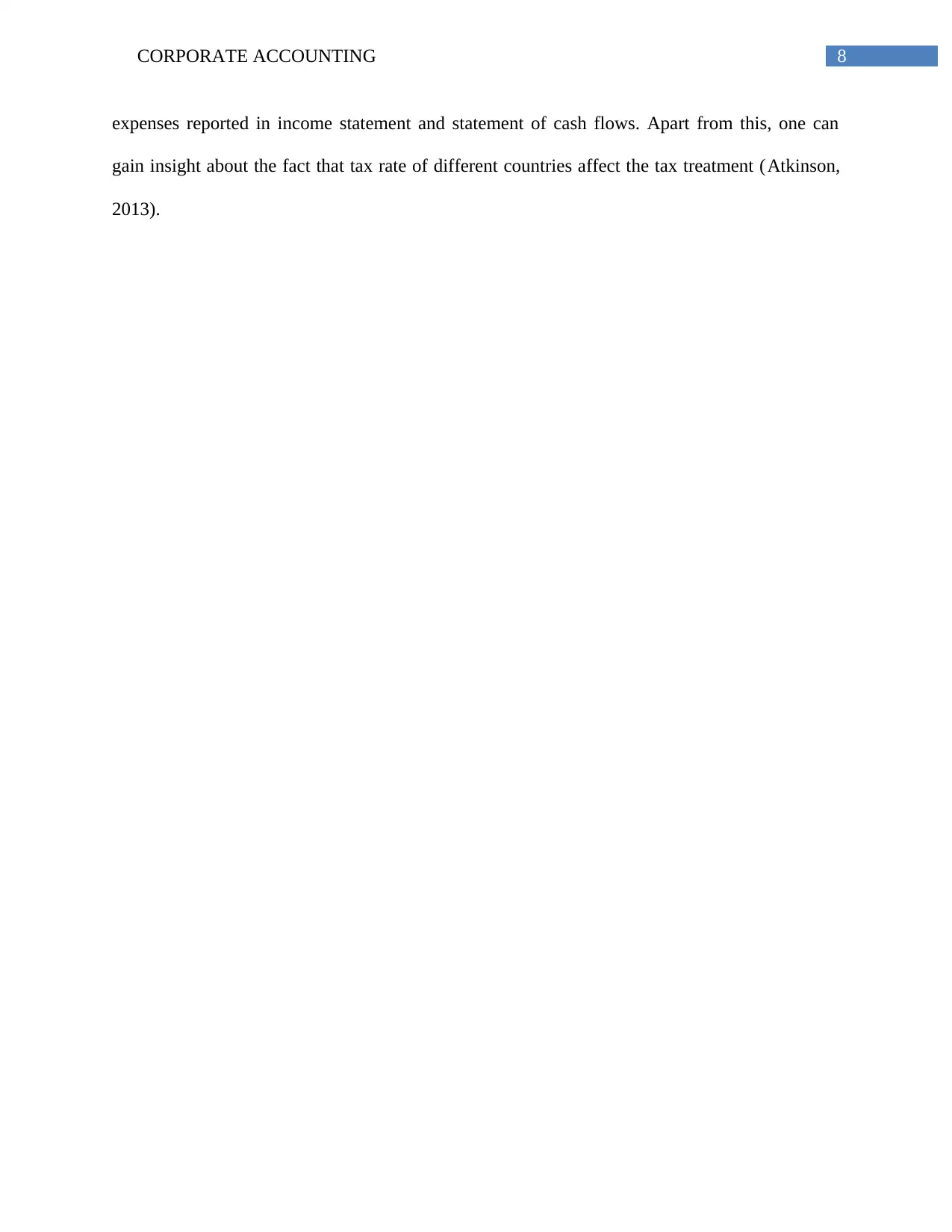
8CORPORATE ACCOUNTING
expenses reported in income statement and statement of cash flows. Apart from this, one can
gain insight about the fact that tax rate of different countries affect the tax treatment (Atkinson,
2013).
expenses reported in income statement and statement of cash flows. Apart from this, one can
gain insight about the fact that tax rate of different countries affect the tax treatment (Atkinson,
2013).
⊘ This is a preview!⊘
Do you want full access?
Subscribe today to unlock all pages.

Trusted by 1+ million students worldwide
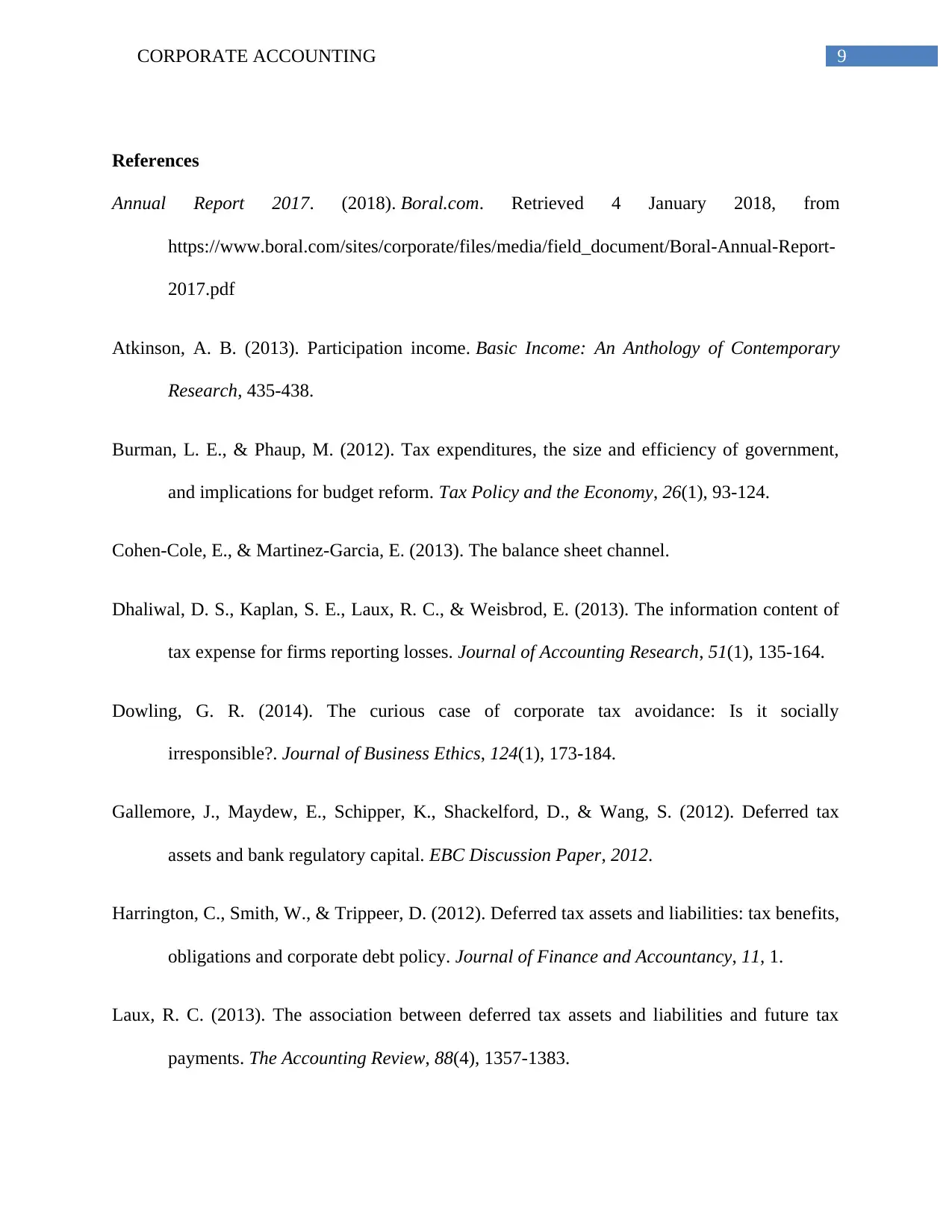
9CORPORATE ACCOUNTING
References
Annual Report 2017. (2018). Boral.com. Retrieved 4 January 2018, from
https://www.boral.com/sites/corporate/files/media/field_document/Boral-Annual-Report-
2017.pdf
Atkinson, A. B. (2013). Participation income. Basic Income: An Anthology of Contemporary
Research, 435-438.
Burman, L. E., & Phaup, M. (2012). Tax expenditures, the size and efficiency of government,
and implications for budget reform. Tax Policy and the Economy, 26(1), 93-124.
Cohen-Cole, E., & Martinez-Garcia, E. (2013). The balance sheet channel.
Dhaliwal, D. S., Kaplan, S. E., Laux, R. C., & Weisbrod, E. (2013). The information content of
tax expense for firms reporting losses. Journal of Accounting Research, 51(1), 135-164.
Dowling, G. R. (2014). The curious case of corporate tax avoidance: Is it socially
irresponsible?. Journal of Business Ethics, 124(1), 173-184.
Gallemore, J., Maydew, E., Schipper, K., Shackelford, D., & Wang, S. (2012). Deferred tax
assets and bank regulatory capital. EBC Discussion Paper, 2012.
Harrington, C., Smith, W., & Trippeer, D. (2012). Deferred tax assets and liabilities: tax benefits,
obligations and corporate debt policy. Journal of Finance and Accountancy, 11, 1.
Laux, R. C. (2013). The association between deferred tax assets and liabilities and future tax
payments. The Accounting Review, 88(4), 1357-1383.
References
Annual Report 2017. (2018). Boral.com. Retrieved 4 January 2018, from
https://www.boral.com/sites/corporate/files/media/field_document/Boral-Annual-Report-
2017.pdf
Atkinson, A. B. (2013). Participation income. Basic Income: An Anthology of Contemporary
Research, 435-438.
Burman, L. E., & Phaup, M. (2012). Tax expenditures, the size and efficiency of government,
and implications for budget reform. Tax Policy and the Economy, 26(1), 93-124.
Cohen-Cole, E., & Martinez-Garcia, E. (2013). The balance sheet channel.
Dhaliwal, D. S., Kaplan, S. E., Laux, R. C., & Weisbrod, E. (2013). The information content of
tax expense for firms reporting losses. Journal of Accounting Research, 51(1), 135-164.
Dowling, G. R. (2014). The curious case of corporate tax avoidance: Is it socially
irresponsible?. Journal of Business Ethics, 124(1), 173-184.
Gallemore, J., Maydew, E., Schipper, K., Shackelford, D., & Wang, S. (2012). Deferred tax
assets and bank regulatory capital. EBC Discussion Paper, 2012.
Harrington, C., Smith, W., & Trippeer, D. (2012). Deferred tax assets and liabilities: tax benefits,
obligations and corporate debt policy. Journal of Finance and Accountancy, 11, 1.
Laux, R. C. (2013). The association between deferred tax assets and liabilities and future tax
payments. The Accounting Review, 88(4), 1357-1383.
Paraphrase This Document
Need a fresh take? Get an instant paraphrase of this document with our AI Paraphraser
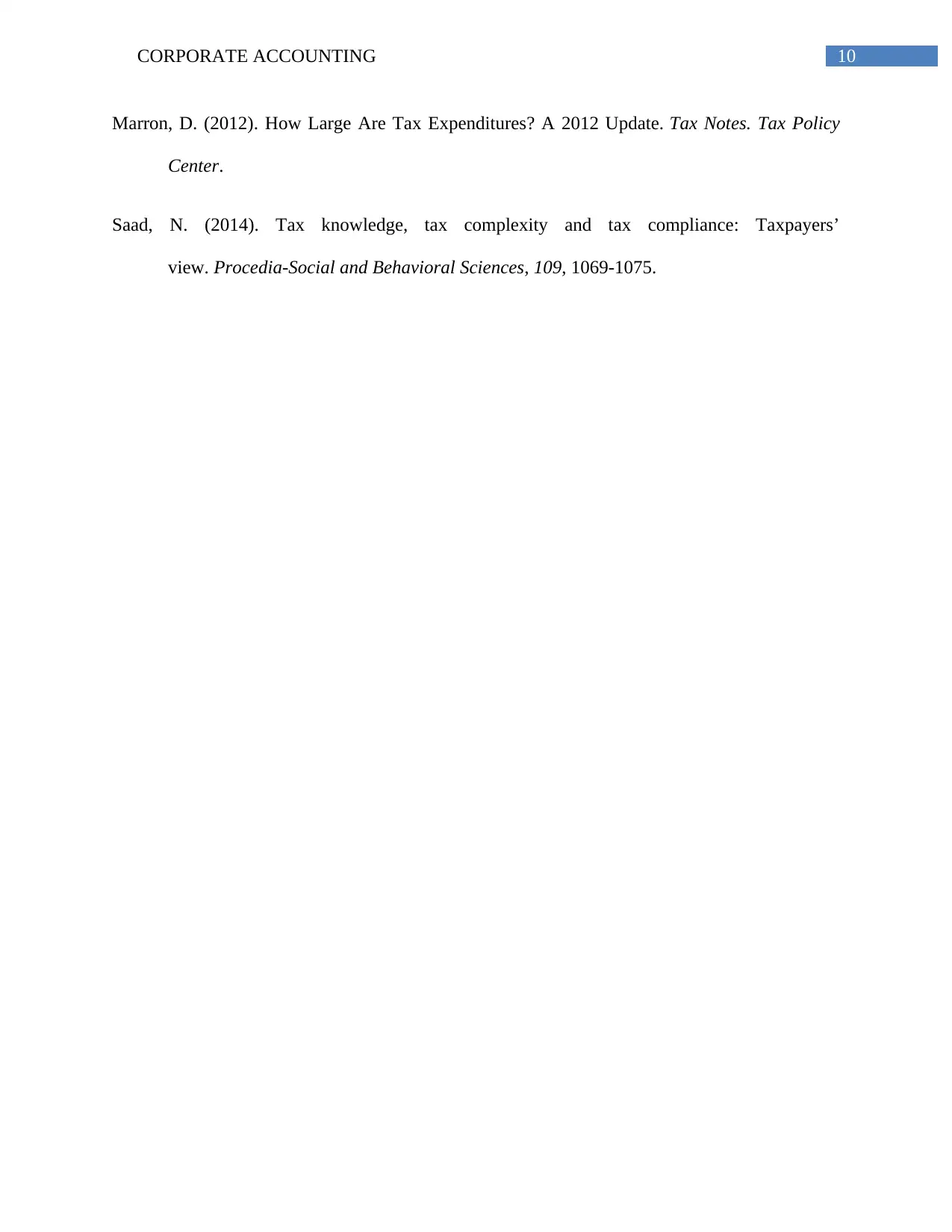
10CORPORATE ACCOUNTING
Marron, D. (2012). How Large Are Tax Expenditures? A 2012 Update. Tax Notes. Tax Policy
Center.
Saad, N. (2014). Tax knowledge, tax complexity and tax compliance: Taxpayers’
view. Procedia-Social and Behavioral Sciences, 109, 1069-1075.
Marron, D. (2012). How Large Are Tax Expenditures? A 2012 Update. Tax Notes. Tax Policy
Center.
Saad, N. (2014). Tax knowledge, tax complexity and tax compliance: Taxpayers’
view. Procedia-Social and Behavioral Sciences, 109, 1069-1075.
1 out of 11
Related Documents
Your All-in-One AI-Powered Toolkit for Academic Success.
+13062052269
info@desklib.com
Available 24*7 on WhatsApp / Email
![[object Object]](/_next/static/media/star-bottom.7253800d.svg)
Unlock your academic potential
Copyright © 2020–2025 A2Z Services. All Rights Reserved. Developed and managed by ZUCOL.





